Introduction
Businesses and organizations worldwide need ways to organize and execute the work required to meet strategic objectives. Project Portfolio Management (PPM) software tools “support the selection, planning and execution of a variety of different work packages or containers, including, but not limited to, traditional projects. They often fold in collaboration and communication capabilities and allow work teams and project offices to report, monitor, and identify course correction in resource-intensive project and work environments[1].”
Software development and digital transformation initiatives make up a considerable chunk of business and government portfolios in any given year. The financial, personnel, and time resources needed are significant. Information Technology (IT) programs and portfolios are strategic and high profile and must be planned and managed with great care.
QSM’s Software Lifecycle Management (SLIM) suite of software tools is sometimes confused with PPM applications. SLIM-Suite doesn’t compete with PPM solutions - they complement them, supporting Project Management Institute (PMI) project and portfolio planning and management standards several ways. SLIM works with PPM tools by providing essential data and capabilities to:
- Produce defensible estimates early in the Initiation and Planning stages
- Track project status and forecast completion during Execution
- Measure project performance to guide Optimization efforts.
In this article we will review PPM and SLIM software capabilities to show how they can work together to improve an organization’s ability to execute their programs and reduce risk.
PPM Software Capabilities
Gartner Peer Insights recently reviewed PPM software providers, rating what the community considers essential or critical capabilities, going beyond tool features alone to include integration, security, usability.
The PPM capabilities identified as essential or critical include:
- Project Demand Management
- Project Planning and Management
- Time Management
- Resource Management
- Resource Capacity Planning
- Project Portfolio Management
- Project Collaboration
- Program Management
- Reporting Services
- Security and User Management
- Integration
- Usability
Over 20 products were reviewed, including Smartsheet, Microsoft Project (Online, Planner, and Server 2016), Wrike, Planview, Monday.com, Clarity PPM, and ServiceNow.
SLIM and PPM Comparison
We used the Gartner PPM essential capabilities list as the basis for showing when and how SLIM capabilities enhance these capabilities to up the game of project portfolio management. Reporting Services, Security and User Management, Integration, and Usability were excluded from the analysis.
The diagram below shows SLIM-Suite and PPM application complimentary capabilities using white labels with connecting lines. For example, SLIM’s Resource Demand Planning capabilities support PPM Resource Capacity Planning capabilities. SLIM and PPM unique features are shown using colored labels. Notice that “management” capabilities are the focus of PPM applications – no surprise! Conversely, SLIM capabilities are designed to provide the critical data and analytics needed to make informed, intelligent business decisions during the planning and management processes. SLIM-Suite focuses on software project estimation, because, with more than 45 years in the business, QSM knows that bad estimates lead to bad plans, which ultimately lead to schedule and budget overruns, or worse, project failure.
Here are seven software project management capabilities you need to up your game or change it entirely:
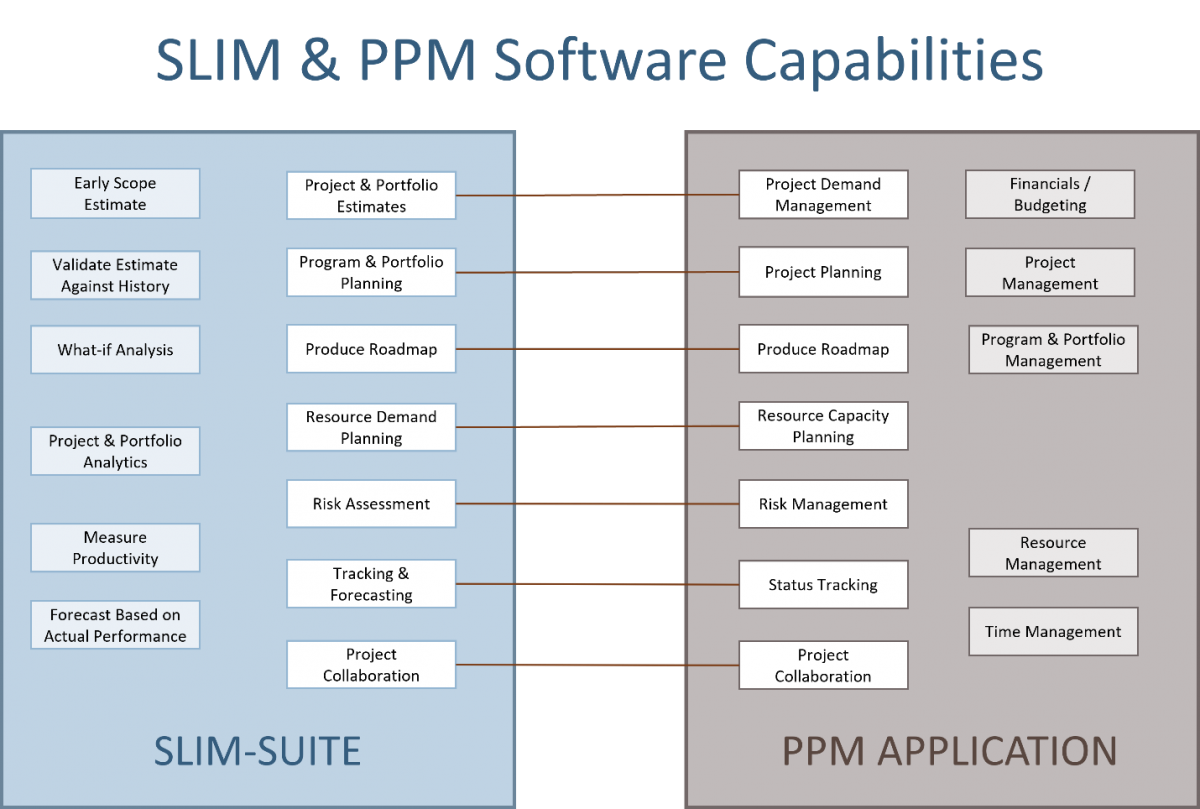
1. Project Demand Management (PPM) − Project & Portfolio Estimates (SLIM)
Demand Management is the allocation of capital, infrastructure, human, and other available resources to initiatives that will create the most value and enable the organization to achieve strategic objectives. Demand Management attempts to find balance in the project management triangle of scope, schedule, and budget.
Let’s face it. It is extremely challenging to balance the projects that provide the most value with the resources you have available or need to get. Resource Demand and Capacity planning is part of Project Demand Management, and we’ll look at those capabilities later in the article.
Before planning begins, you need a reliable way to evaluate the feasibility of each idea or project. Key questions to ask are:
- What value will the proposed project provide?
- How much will it cost?
- How long will it take?
- Do we have available skilled resources to do it?
- What are the risks?
SLIM’s Top-Down Estimation methodology, backed by over 14,500 industry database of completed projects, helps you quickly identify unrealistic expectations. The business side of the organization rarely has enough information to know if their desired schedule and budget are in line with the delivery side’s capabilities. Proposing a schedule of 8 months and budget of $1 million sounds doable.
You need a way to validate project goals against history, using industry data or your own, to stay out of the Impossible Zone – schedule and effort assumptions that are not achievable.
QSM’s SLIM-Estimate tool computes single project or release estimates. The diagram below shows how our SLIM-PPM Connector for Clarity integration (1.) reads the proposed project’s cost and schedule data from Clarity’s Financial Summary tab, and along with an (2.) estimate of software size, determines if the productivity required to achieve the goals are in line with industry performance. Estimators can propose achievable alternative solutions and update the financial information in Clarity (3.). The PPM integration can be modified to work with your PPM application. Contact QSM for more information.
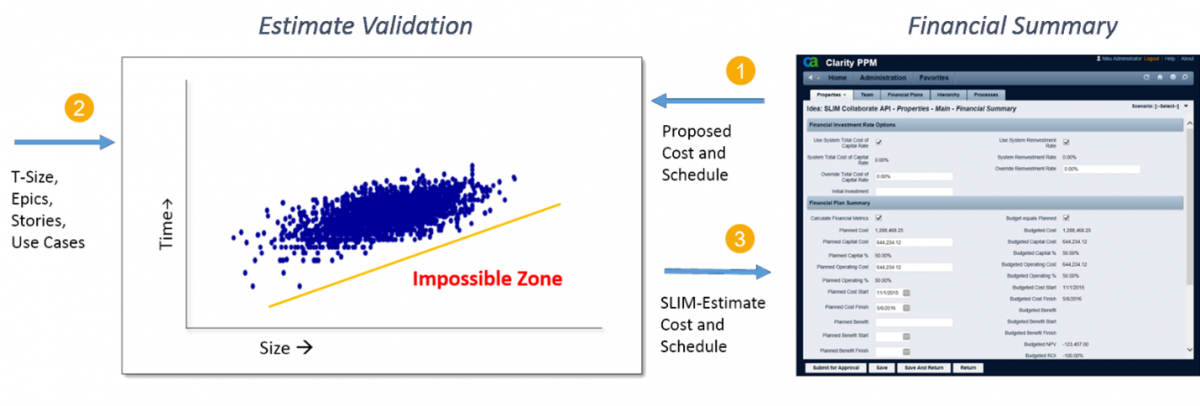
SLIM-MasterPlan aggregates multiple software project estimates and non-software tasks to model complex programs and your entire portfolio. A flexible Program Builder lets you define a hierarchy with summary tasks, dependencies, and milestones that brings great visibility to not only the overall schedule, but aggregate view of staffing (more on this in the Resource Capacity Planning section), cost, product or value completion, and quality.
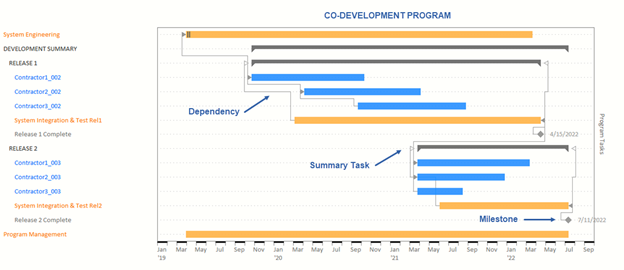
2. Project Planning (PPM) − Program & Portfolio Planning (SLIM)
The primary goals of the planning stage are to develop the portfolio management plan and reach agreement on scope, budget, priorities, interdependencies, risks and issues, and resourcing requirements. It is challenging enough to plan a single software project. Portfolio planning is even more difficult because they are complex aggregations of an organization’s projects and programs over an extended period, which may span one to five years.
SLIM-Suite applications are not planning tools that help you create detailed tasks lists, assign resources to tasks, or prioritize and manage the product backlog. SLIM keeps you from wasting precious time and resources building out the wrong plan! SLIM-Estimate, SLIM-MasterPlan, and SLIM-Collaborate all provide a powerful What-if capability to quickly explore what might happen and assess the tradeoffs. Top-down estimation shows the potential impact of changes in scope, budget, priorities, interdependencies, and issues.
SLIM tools generate high-level project plans that provide enough detail to help you select the estimate scenario you can commit to, which guides detailed planning. This dashboard from SLIM-Estimate shows the Average Staffing and associated Cumulative Cost over time, plus a build-up of Cumulative Integrated Story Points and a Defect prediction curve. You can create a Work Breakdown Structure (WBS), or import/export from Microsoft Project, to show the effort and duration required for major tasks.
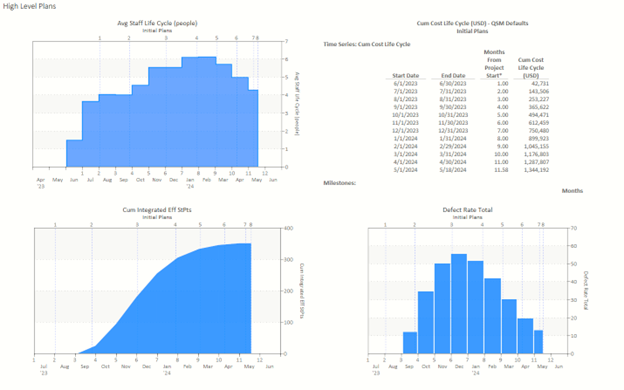
In his webinar on Best Practices for IT Portfolio Budgeting, Doug Putnam demonstrated how a macro-level estimation process can leverage the very basic information typically available early in the development cycle to generate release level budgeting information, and how to aggregate the releases using SLIM-MasterPlan to visualize your portfolio plan.
Project level plans from SLIM-Estimate, including, effort, cost, staffing, construction, and defects, can be viewed at different levels of aggregation to show different groups, such as product lines, programs, resource skills, or the entire portfolio.
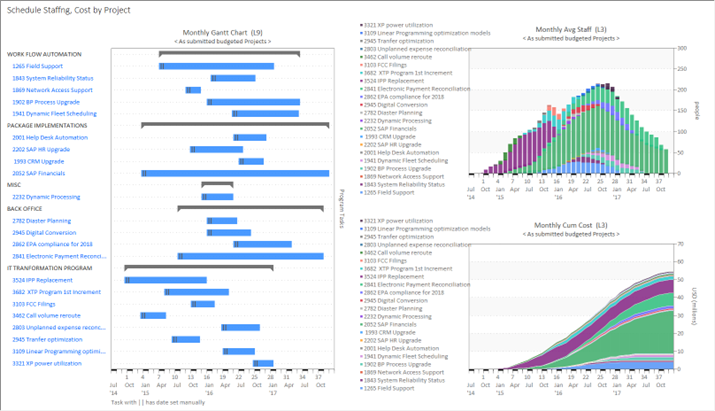
3. Resource Capacity Planning (PPM) − Resource Demand Planning (SLIM)
Capacity planning is the process of determining the potential needs of your project. The goal of capacity planning is to have the right resources available when you’ll need them. Without credible demand data, even the best analytics are only a poor guess.
PPM systems let you:
- Enter the placeholder resources
- Find actual resources to replace the placeholders
- Roll up the placeholder for analysis and planning
But how do you know how many of each type of resource you need? Getting a realistic estimate of resource needs is not the role of the PPM system, and that's the missing ingredient. SLIM-Estimate lets you define the resource roles, or Skill Categories, needed for a particular project type. The high-level project plans can be broken out to determine the staffing, effort, and cost requirements by skill, by month.
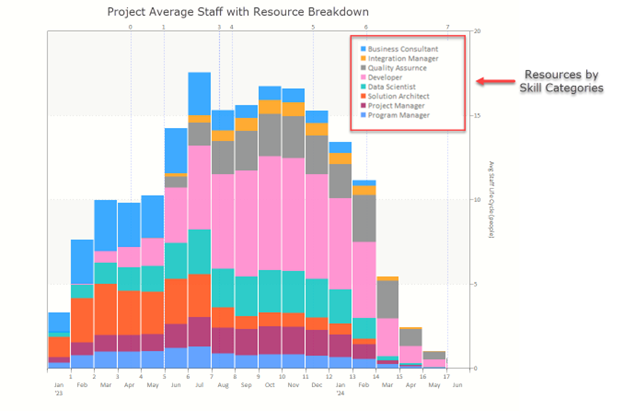
Earlier we showed how SLIM-PPM Connector for Clarity integration helps estimators propose achievable alternative solutions and update the financial information in Clarity and that this integration can be modified to exchange data with other PPM solutions. The integration also extends the resource demand planning in SLIM to compute detailed plans that leverage your resource data by:
- Reading your PPM solution resource characteristics data to define subskills by location, level of expertise and experience, or whether they are internal or external to the organization, and use the labor rate for those skills to compute cost
- Select roll-on/roll-off and other options to determine how resources will be assigned to the project, e.g., first on/first off
- Export the detailed resource demand plan to populate the Team page or similar view

Aggregating project resource data in SLIM-MasterPlan provides a portfolio level resource demand plan that can be used to adjust project start dates, scope, or other assumptions to ensure the demand is in line with your capacity.
4. Risk Management (PPM) − Risk Assessment (SLIM)
Risk assessment determines possible mishaps, their likelihood and consequences, and the tolerances for such events. The results of this process may be expressed in a quantitative or qualitative fashion. Risk assessment is an inherent part of a broader risk management strategy to help reduce any potential risk-related consequences.
The major risk for software projects is the potential to:
- Overrun the schedule
- Overrun the budget
- Fail to deliver the desired scope or value
And these risks are usually a result of poor estimates due to uncertainty and a lack of understanding of software project behavior. Software project estimates must be provided when uncertainty levels are high. SLIM tools use Monte Carlo Simulation to use the uncertainty about scope, productivity, and cost to compute probabilities for achieving schedule and budget goals. This SLIM-Collaborate chart shows the cumulative cost of a software project estimate (Current Solution) and the amount of contingency or management reserve required to achieve a 90% probability of not exceeding the budget. The same data is available for staffing levels and project duration.
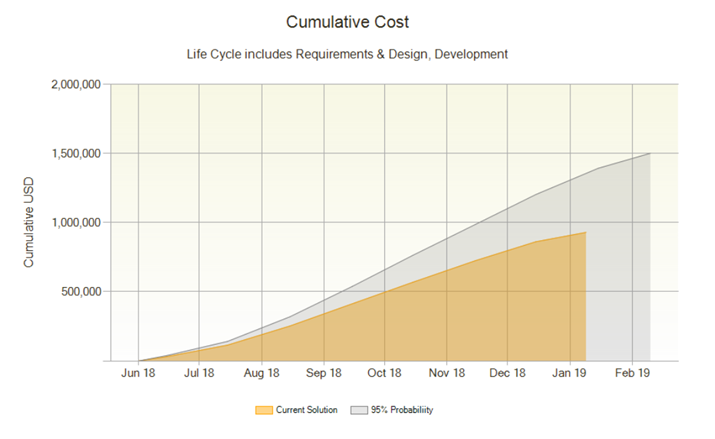
The other aspect of software project risk is that schedules and budgets proposed for projects and ideas are often based upon unrealistic expectations, as mentioned in the Project Demand Management section. It is simply a lack of awareness because organizations fail to measure project performance and use that history as a basis of estimation.
SLIM’s quadrant charts let you view your portfolio from 10,000 feet and identify risky projects based on their goals, as compared to QSM industry database or your custom trends. Plotting average historical performance for productivity, duration, effort, or staffing on the X and Y axes creates quadrants that represent overly optimistic and pessimistic outcomes. The blue bubble data points can display cost, scope, or other metrics. Notice that a handful of projects in the upper left quadrant are outside the target zone because the productivity and schedule are outside of acceptable ranges. Conversely, two large, probably strategic projects, propose long schedules and lower than average productivity.
This type of analysis facilitates portfolio risk management by identifying opportunities to save money and/or avoid disaster and negotiate plans that reduce risk.
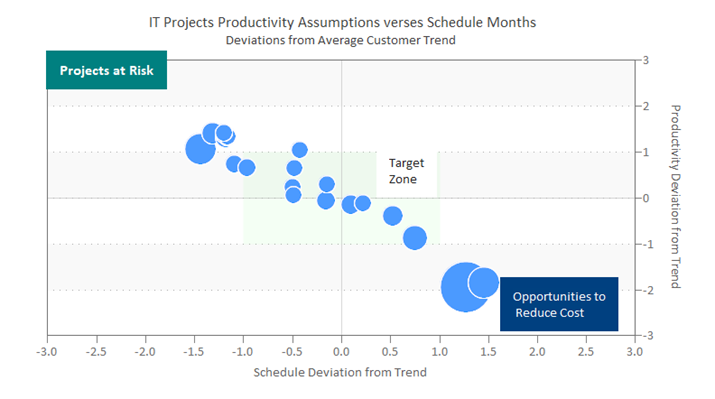
5. Produce Roadmap (PPM) − Produce Roadmap (SLIM)
Project and/or product roadmaps provide a strategic overview of the major elements of programs and portfolios. It should include objectives, milestones, deliverables, resources, and planned timeline.
Can you see the big picture of a multi-faceted project or portfolio of projects and quickly determine how changing one project’s scope, staffing or productivity will impact the whole portfolio?
You have already seen the Gantt views of a complex program and portfolio in the Program Demand Management and Project Planning sections. SLIM-MasterPlan provides more than a roadmap. It is like a GPS navigation system that lets you explore alternative routes and the associated distance and travel time. You can use the global What-If capability to assess the impact of scope, staffing, and productivity changes. Use the interactive user interface to model late project starts, schedule overruns, or dependencies, and drill-down to the project details. The ability to log and compare alternative roadmap options (see image below) helps you select the best course throughout the portfolio lifecycle.

In the next section, Status Tracking, you will learn how you can quickly and reliably forecast outcomes of in-flight projects to ensure the big picture is accurate.
6. Status Tracking (PPM) − Tracking & Forecasting (SLIM)
Project tracking monitors progress by comparing actual versus plan data on scope, staffing, cost, schedule, and many other important measures to identify issues and take corrective action when necessary.
When software projects veer off track or change in scope, can you easily forecast new schedules and budgets? Are you frustrated by cost and schedule overruns on software projects your enterprise PPM system rated "low risk"? Do you need a better, more quantitative way to manage your outsourced vendor-developed projects?
QSM’s SLIM-Control shows you if your software projects are on course and where corrective action is needed if they are not. Using statistical process control techniques, SLIM-Control compares project plans against project actuals—then generates a forecast to completion. You can run multiple forecasts, compare them, and then select the most reliable forecast and make it the new plan. It offers both built-in and user-defined metrics, as well as earned value charting and reporting.
The chart below shows the planned number of Story Points to be developed (blue line), actual (red line), plus the forecast to complete (green line) based on actual performance. Customizable control bounds let you specify your tolerance for deviations. Notice that although the traffic light warning in the upper left corner is green, the completed cumulative value (Story Points) is behind and forecasted to require at least two more sprints.
![]()
When you import project actual + forecast data into your SLIM-MasterPlan roadmap, you get a comprehensive Scoreboard Report that shows traffic light status for all on-going projects in your portfolio based on the metrics that are most important to you.
![]()
7. Project Collaboration (PPM) − Project Collaboration (SLIM)
Collaboration simply means working together, which in today’s world requires easy information access and sharing, communication facilitation, and sometimes process workflow enablement. Collaboration is critical to successful implementation of the Scaled Agile Framework (SAFe), designed to enable Business Agility and Organizational Agility, defined as follows:
- Business Agility - the ability to compete and thrive in the digital age by quickly responding to market changes and emerging opportunities with innovative business solutions.
- Organizational Agility - describes how Lean-thinking people and Agile teams optimize their business processes, evolve strategy with clear and decisive new commitments, and quickly adapt the organization as needed to capitalize on new opportunities.
QSM’s web-based solution, SLIM-Collaborate provides project intelligence to stakeholders to ensure the right people have access to the right information at the right time − improving visibility, transparency, and global collaboration. SLIM-Collaborate is structured into four main services for managing project and portfolio information, as shown in the diagram below:
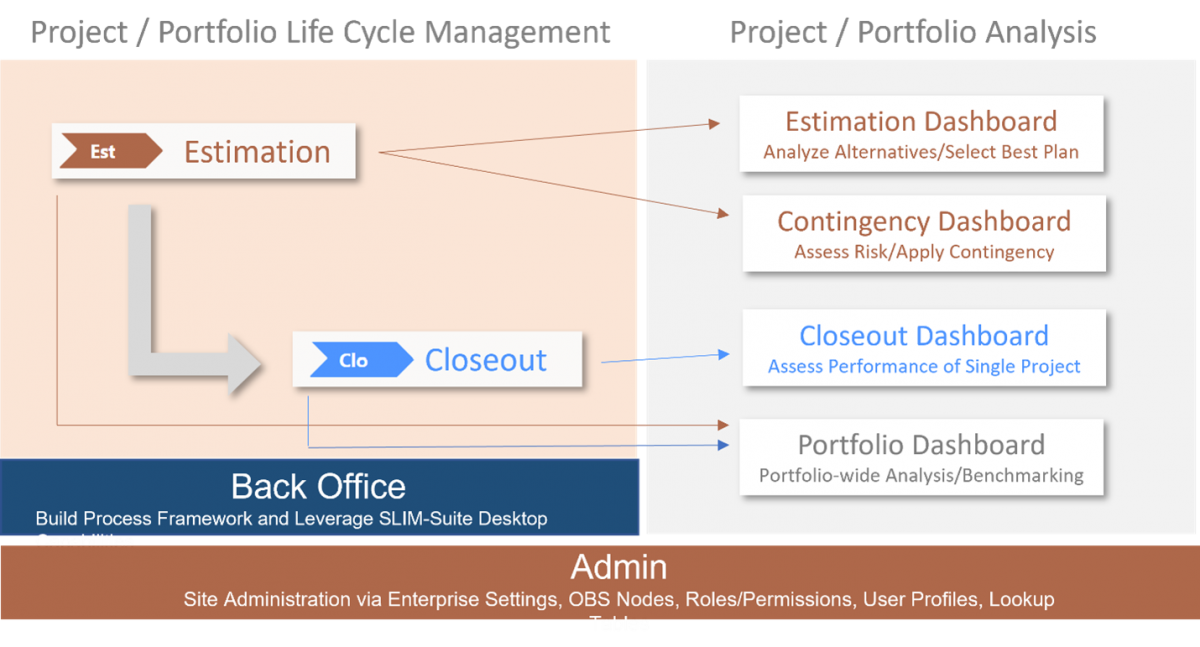
- Project / Portfolio Life Cycle Management – Stakeholders are granted view or edit privileges to contribute to project estimation during the Estimation stage, and to project Closeout features to capture and analyze actual performance data once the project is complete.
- Project / Portfolio Analysis – Performed using project and portfolio dashboards. Project Dashboards used while working with projects in the estimation and closeout stages, present detailed data about estimate assumptions, alternative solutions, contingency and relative risks, and performance benchmarking focused on the core measures of size, productivity, effort, cost, duration, and defects. Portfolio dashboards analyze project status, performance, and other characteristics by lifecycle stage, organization, and other groupings.
- Back Office – The Back Office service enables SLIM experts to define templates, sizing methods, trend lines, and other SLIM desktop tool components that establish a tailored enterprise project estimation and management process.
- Admin – The Admin service maintains site access and enterprise settings by configuring user roles, permissions, organizational structures, and common project data.
Summary
Businesses and organizations define work packages and projects to organize and execute the work required to meet strategic objectives. PPM software tools provide essential data and capabilities for planning and executing of a variety of projects. Software projects make up a large portion of PMO initiatives and present technical and financial risks due to uncertainty. We reviewed seven PPM capabilities and showed how SLIM-Suite tools enhance each capability to help you up your game by providing data and analytics that lead to successful software projects.

